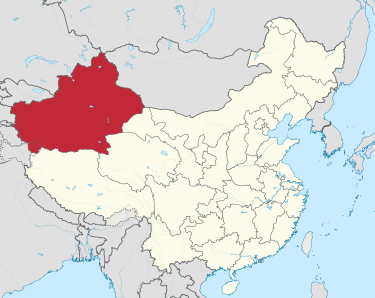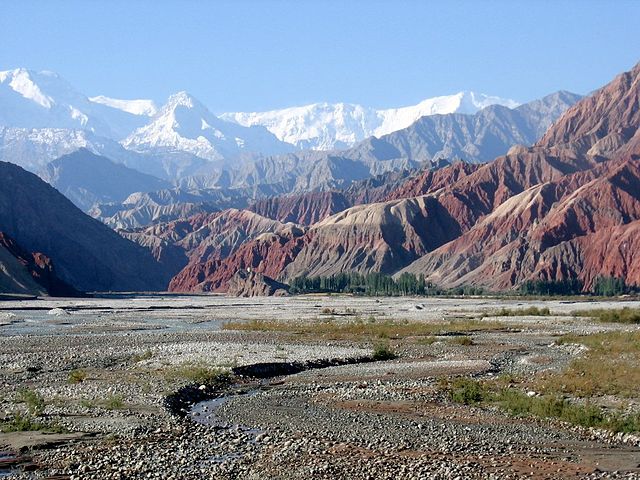Paul Hattaway: Xinjiang: China’s Gateway to the World
 Paul Hattaway, Xinjiang: China’s Gateway to the World (United Kingdom: Piquant Editions, 2022), 359 pages, ISBN 9781803290058.
Paul Hattaway, Xinjiang: China’s Gateway to the World (United Kingdom: Piquant Editions, 2022), 359 pages, ISBN 9781803290058.
This book is volume 6 of Paul Hattaway’s China Chronicles Series. It focuses on the province of Xinjiang, which is located in the northwest area of China, it serves as a passageway “between China and the rest of the world” (page 1). It is the largest province in China and borders the countries of “India, Pakistan, Afghanistan, Tajikistan, Kazakhstan, Kyrgyzstan, Russia, and Mongolia” (page 2). The province began being called Xinjiang in 1759 when it was given this name by rulers who were part of the Qing Dynasty (pages 4, 21-22). The author also mentions other interesting facts about this province, including its population numbers, which, with one exception, have grown over the years (page 3), that Marco Polo visited this area (pages 6-8), and that Islam is believed to have entered the province in AD 708 (page 8). Xinjiang has been the entry point not only for Islam but for a number of other religions as well including Buddhism, Zoroastrianism, and Christianity (page 15). Islam spread in this area through the use of force (pages 24, 26). Hattaway says that the province has experienced great cruelty throughout the centuries (page 13). In early 2021 it was believed that there were about 15,000 mosques in the province, this is, at least in part, due to the presence of the Uyghurs (page 29).

Xinjiang Province within China.
Image: Wikimedia Commons
But the focus of the book, as is true of all the other books in the series, is the Christian history of the area. Hattaway says that the history in this province can be divided into two major eras. The first concerns the significant impact that Nestorian Christians had in the area from 7th century through to the 13th century, and the second is the spread of the faith in the last century and a half (page 13). The author further notes that Swedish believers carried on significant ministry in Xinjiang and that Muslims in this province came to faith in Christ, hundreds of them (pages 13-14). In the book he covers Catholic missions (pages 43-54) but he indicates that Catholics make up a very small part of Christians in Xinjiang (page 54). The majority of the text is given to a consideration of Protestant missions and native Chinese workers. Hattaway says that today there are approximately “twenty times as many church members” in Evangelical Christianity as in Catholicism (page 54). As readers work their way through the book, they will find that many of the chapters are given to consider particular decades of Christian history. There are chapters devoted to the 1890s (pages 55-65), 1900s-1910s (pages 66-77), 1920s (pages 101-116), 1930s (pages 124-135), 1940s (pages 153-161), 1950s-1960s (pages 196-203), 1970s-1980s (pages 204-216), 1990s (pages 217-230), 2000s (pages 231-253), and the 2010s (pages 273-281). In addition to these chapters there are others devoted to key missionaries who served in Xinjiang and important events that took place there.
One chapter is devoted to George Hunter who was born in 1861, he was a Scottish missionary who served in the northwest part of China for 57 years carrying on significant ministry to Muslims (page 78). Hunter was called the “Apostle of Turkestan” (page 78). He could preach in 7 different languages (page 82), did not like the limelight (page 78), and never married (page 79). It seems that he did not see a lot of conversions as a result of his ministry (page 85). However, he remained undeterred in the work of evangelism (page 87). He was a picture of commitment.
Not all of God’s heroes are household names.
Other chapters describe the ministries of Percy Mather (page 92-100), the Trio (pages 117-123), the Back to Jerusalem Evangelistic Band (pages 162-176), the Northwest Spiritual Band (pages 177-186), and Simon Zhao (pages 187-195). Percy Mather was born in England and became a close friend of George Hunter (page 92). Like Hunter he was affiliated with the China Inland Mission (pages 79, 93), was unmarried (page 93), and engaged in outreach to Muslims (page 97). In addition, he produced a lot of written resources on the mission field (page 95). The Trio was a group of three single British women: Eva French, Francesca French, and Mildred Cable (page117). One was in her late 40s and the other two were in their 50s at the time they went into Xinjiang (page 118). They braved the heat of the land and ministered to people of both low and high degree in society (page 119). They preached the gospel, even amid Muslim opposition (page 122). They were honored by the Queen of England, and Francesca French and Mildred Cable wrote the biographies of George Hunter and Percy Mather (pages 122-123). The Back to Jerusalem Band was a group of Chinese believers, both men and women, who felt called to Xinjiang and other places to reach the Muslims (page 162). There were multiple groups that made up this band (pages 162, 168). The Northwest Spiritual Band came into being when some people split from the Jesus Family, which was a network of churches (page 178). It was not a large group, but they did reach Muslims for Christ (page 179). Simon Zhao, also a native-born Chinese, was a leader in the Northwest Spiritual Band who felt directed by the Lord to focus on Xinjiang (page 187). He met others who also felt a call to the province and beyond (page 188). He and other members of the Northwest Spiritual Band went with him into Xinjiang, not long after that they were imprisoned, Zhao was the only one to come out alive (page 188). He spent 31 years in prison and was beaten much of the time he was there (page 191). Hattaway, drawing largely from other sources, points out that when Zhao was finally released, he had a profound impact on the believers in China (pages 193-195).

This photograph of the Pamir mountains was taken near Karakoram Highway in Xinjiang.
Image: Wikimedia Commons
In addition to the chapters I have already mentioned there are some that focus on other topics as well. These included chapters on: The Modern Back to Jerusalem Movement (pages 254-272) and the Future of the Church in Xinjiang (pages 306-310). Throughout this book you will find the names of people who have engaged in Christian ministry in Xinjiang.
As is true of all of the volumes in the China Chronicles Series, this volume contains a wealth of pictures throughout its pages. It also contains extensive facts and figures in the tables found toward the back of the book. Paul Hattaway has once again brought to light some Christian history that we would likely not find on our own. This volume demonstrates that not all of God’s heroes are household names. Some have served very faithfully outside of the spotlight. Their life stories are truly challenging and inspiring.
Reviewed by John P. Lathrop











Leave a Reply